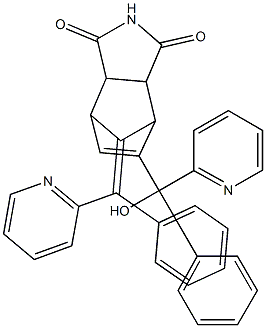|
|
| | NORBORMIDE Basic information |
| Product Name: | NORBORMIDE | | Synonyms: | Raticate;NORBORMIDE;4,7-methano-1h-isoindole-1,3(2h)-dione,3a,4,7,7a-tetrahydro-5-(hydroxyphenyl-2;a-2-pyridylbenzylidene)-;compounds-6,999;ent51,762;mcn1025;mcneil1025 | | CAS: | 991-42-4 | | MF: | C33H25N3O3 | | MW: | 511.57 | | EINECS: | 213-589-6 | | Product Categories: | | | Mol File: | 991-42-4.mol |  |
| | NORBORMIDE Chemical Properties |
| Melting point | 190-198° | | Boiling point | 598.31°C (rough estimate) | | density | 1.2065 (rough estimate) | | refractive index | 1.7800 (estimate) | | storage temp. | Amber Vial, -20°C Freezer, Under inert atmosphere | | solubility | Chloroform (Slightly), Methanol (Slightly, Heated) | | form | Solid | | color | Crystals | | Water Solubility | 60mg/L(room temperature) | | Stability: | Light Sensitive | | EPA Substance Registry System | Norbormide (991-42-4) |
| Hazard Codes | Xn | | Risk Statements | 22 | | RIDADR | 2588 | | HazardClass | 6.1(a) | | PackingGroup | I | | Hazardous Substances Data | 991-42-4(Hazardous Substances Data) | | Toxicity | LD50 in rats (mg/kg): 5.3 orally; 0.65 i.v. (Roszkowski) |
| | NORBORMIDE Usage And Synthesis |
| Description | Norbormide was first introduced on the market in 1964 as
a selective raticide, but does not have a current registration for
commercial use in the European Union or North America.
Current use as a pesticide is minimal to nonexistent worldwide.
This compound’s toxicity is highly specific for rats. | | Chemical Properties | Nonyl trichlorosilane is a clear fuming liquid.
Irritating odor. | | Chemical Properties | White solid. Insoluble in
water; soluble in dilute acids. | | Uses | The only commercial use was as a rodenticide specifically for
Rattus species. However, there have been some reports of this
compound or its derivatives being investigated as a calcium
channel blocker for use as a potential drug to treat human
cardiovascular disease. | | Uses | Norbormide is used as a rodenticide. It acts as a vasoconstrictor and calcium channel blocker, but is selectively toxic to rats and has relatively low toxicity to other species, due to a species specific action of opening the permeability transition pores in rat mitochondria. | | Definition | A rodenticide specific for rats,
supposedly nontoxic to other animals or to humans
. | | General Description | Colorless to off-white crystalline powder. Used as a selective rat poison. | | Reactivity Profile | When heated to decomposition, NORBORMIDE emits toxic fumes of nitrogen oxides. Avoid alkalis. [EPA, 1998]. | | Hazard | Toxic by ingestion. | | Health Hazard | Moderately to highly toxic to humans. Probable human lethal dose is 50 to 500 mg/kg, or 1 teaspoon to 1 pint for a 150 lb. person. | | Fire Hazard | When heated to decomposition, NORBORMIDE emits toxic fumes of nitrogen oxides. Avoid alkalies. | | Safety Profile | Poison by ingestion andintravenous routes. A rodenticide. When heated todecomposition it emits toxic fumes of NOx. | | Potential Exposure | This material is used as a selective,
fast acting rat poison. | | Environmental Fate | Because of its use as a rodenticide, norbormide may have
entered the environment, particularly as a soil contaminant.
The vapor pressure for norbormide is estimated to be
4.3 ×10-22 mmHg at 25 ℃, while Henry’s constant is
2.7 × 10-23 atmm3 mol-1. Therefore, volatilization from wet
or dry soil is not likely to occur. If present in contaminated soil,
norbormide may be transported in the air and undergo wet or
dry deposition. Also, with a Koc of 2000, there would be some
minor soil mobility. The high Koc coupled with a bioconcentration
factor (BCF) of 290 predicts that norbormide
contaminating aquatic systems would adsorb to suspended
solids or sediments and would bioconcentrate. | | Shipping | UN2588 Pesticides, solid, toxic, Hazard Class:
6.1; Labels: 6.1-Poisonous materials, Technical Name
Required. | | Toxicity evaluation | Norbormide causes an extreme and irreversible vasoconstriction
in small arteries in rats following both systemic and local
administration. However, large rat arteries (e.g., aorta),
nonvascular rat smooth muscles (e.g., duodenum and trachea),
and all smooth muscles from non-rat species do not constrict
even at high concentrations/doses of norbormide. The massive
peripheral vasoconstriction in small rat arteries subsequently
reduces coronary blood flow rate, leading to cardiac arrhythmias
and possible death. However, small artery vasoconstriction
in vascular beds supplying other organs (e.g., brain,
kidney, and liver) and subsequent severe ischemic damage are
likely responsible for death in most cases. The norbormideinduced
vasoconstriction is mediated by activation of phospholipase
C/protein kinase C and calcium influx via L-type
voltage-dependent calcium channels. In contrast, norbormideresistant
arteries and smooth muscles exhibit inhibition of
L-type voltage-dependent calcium channels and instead exhibit
a mild relaxation response. A lethal dose of norbormide in rats
(1 g kg-1) can also elevate the blood glucose level twofold with
a decrease in both liver and muscle glycogen. Exposed animals
became comatose within 30 min to 2 h after treatment. The
hyperglycemic effect of this compound in rats is considered to
be a secondary effect. | | Incompatibilities | Compounds of the carboxyl group react
with all bases, both inorganic and organic (i.e., amines)
releasing substantial heat, water and a salt that may be
harmful. Incompatible with arsenic compounds (releases
hydrogen cyanide gas), diazo compounds, dithiocarbamates,
isocyanates, mercaptans, nitrides, and sulfides
(releasing heat, toxic and possibly flammable gases), thiosulfates
and dithionites (releasing hydrogen sulfate and
oxides of sulfur). | | Waste Disposal | Small amounts may be treated
with alkali, then landfilled. Large amounts should be incinerated
. In accordance with 40CFR165, follow recommendations
for the disposal of pesticides and pesticide
containers. Must be disposed properly by following package
label directions or by contacting your local or federal
environmental control agency, or by contacting your
regional EPA office. |
| | NORBORMIDE Preparation Products And Raw materials |
|